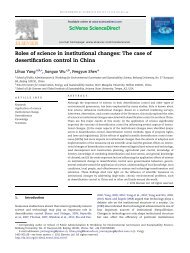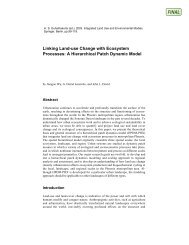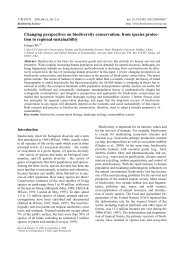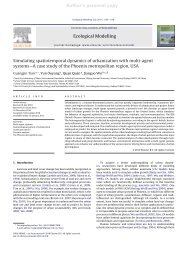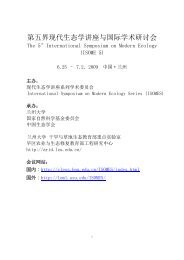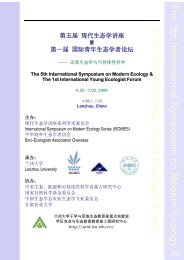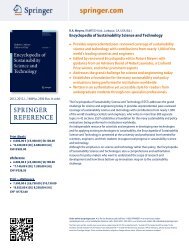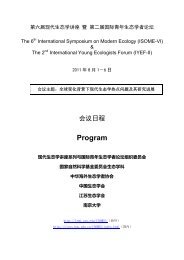Download PDF - Springer
Download PDF - Springer
Download PDF - Springer
You also want an ePaper? Increase the reach of your titles
YUMPU automatically turns print PDFs into web optimized ePapers that Google loves.
220 BERLING-WOLFF AND WU<br />
more likely it will be urbanized. Phases 2 and 3 are combined to represent random new<br />
developments spreading into several cells from booming development—a representative of<br />
a large development springing up. Again, a location is randomly selected and a random<br />
number (1–100) is generated. If the random number is less than the Breed Coefficient, the<br />
cell is being considered for urbanization. As in Phase 1, the slope at that location is used<br />
to determine whether to reject it outright, and if not, the cell is urbanized. Thus, the Breed<br />
Coefficient limits the number of cells to be considered and the slope limits the cells actually<br />
selected.<br />
Phase 3 is applied only to those cells urbanized in phase 2. Once the cell has been<br />
urbanized, a random neighbor (8-neighbor rule) is selected. If the cell is not rejected outright<br />
based on the slope at that location, that cell is urbanized also. This spread is repeated 3<br />
times, urbanizing up to 4 cells in one pass. Phase 4 represents the spread of existing urban<br />
areas into adjacent non-urbanized land. For a randomly selected cell neighboring an existing<br />
urban area, if a random number (1–100) is less than the Spread Coefficient, if at least 4 of its<br />
neighbors are also urban, and if the slope is allowable, it is urbanized. Phase 5 represents the<br />
spread of urbanization along transportation corridors. Some of the cells that were urbanized<br />
in the last time step are selected randomly based on the Diffusion Coefficient. One of these<br />
cells is selected at random, and if a cell of type “road” exists nearby, a walk is taken along<br />
the road (a cell to cell traverse, staying on the road cells) for the distance of 2 * Diffusion<br />
Coefficient. Once traveling has stopped, if the endpoint cell is not rejected outright based<br />
on the slope, the cell is urbanized. The Diffusion Coefficient limits the number of cells to<br />
be considered as starting points for road traversal as well as the distance traveled along the<br />
road. The Road Gravity parameter limits the distance for which a neighboring road will be<br />
searched. Again, the flatter the slope, the more likely a cell is urbanized.<br />
There are four major types of data used within the HILT model: (1) land-use data, (2)<br />
slope, (3) transportation and (4) protected lands. Land-use data and protected lands are used<br />
to determine the initial cell values at the start of simulation. The slope associated with each<br />
grid cell is used to determine the likelihood of urban growth development along hillsides,<br />
and the road information is used to influence the urbanization along transportation corridors<br />
(which in Phoenix tends to parallel the water distribution system).<br />
Major modifications to HILT<br />
We tested the applicability of HILT for the Phoenix region without any modification to the<br />
model structure by running the model from 1975 to 1995 with mid-range default parameter<br />
values. Land use data of 1975 and 1995 were used for model initialization, calibration<br />
and evaluation (see the following sections for more detail on running such simulations).<br />
These simulations produced only a fraction of the actual urban growth in the region. Then,<br />
we increased the parameters to their maximum values, but the model still significantly<br />
underestimated the urban growth. Our error analysis showed that 88% of the cells predicted<br />
as urban (this includes both seed and converted cells) were correct (user’s accuracy), but that<br />
only 33% of the urban growth was actually generated by the model (producer’s accuracy).<br />
Clearly, the model, without modification, was not able to adequately simulate the urban<br />
growth in the Phoenix metropolitan area. We realized that some new components needed




